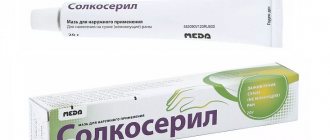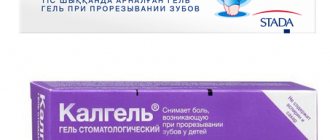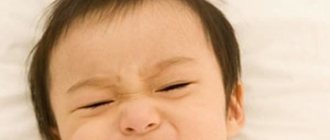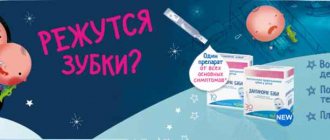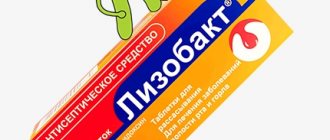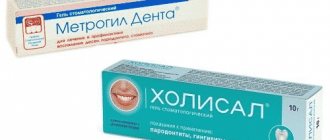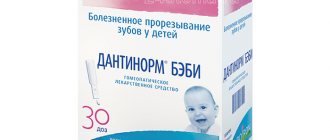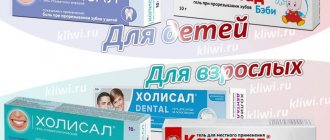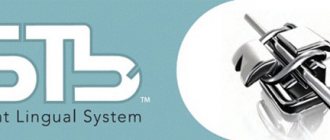From about six months of age, the baby begins to erupt his first teeth - the front row, the lower jaw. In addition to the direct growth of teeth, you can observe:
- Sleep disturbances, frequent whims and awakenings for no reason at night
- Gums become inflamed, red, and swollen
- The child takes everything in his mouth and chews
- Body temperature can rise to 38 degrees, but lasts no more than three days
- The baby becomes nervous and refuses to eat.
The best method of symptomatic treatment of an erupting tooth is the use of modern gels. These drugs contain an anesthetic that, when applied locally, relieves pain without penetrating into the systemic bloodstream. Also, if the gel is good, then in addition to the anesthetic, its composition should include softening and anti-inflammatory components, and antiseptics.
Kalgel or Cholisal - which is more effective?
During teething in children, the likelihood of infection of the gum mucosa increases. To ease the pain and burning sensation, the baby begins to chew objects that he can reach. During the day, pathogenic bacteria and pathogenic fungi settle on toys or books. After their penetration into the oral cavity, there is a risk of an inflammatory process. The use of Cholisal or Kalgel will help prevent such negative developments. They are characterized by the following therapeutic properties:
- relief of inflammation and swelling of the gums;
- elimination of pain of any intensity;
- preventing the spread of infection to healthy areas of the oral cavity.
Cholisal fights inflammation much more effectively due to its active ingredients. They quickly destroy pathogenic microorganisms and disinfect mucous membranes. Kalgel relieves pain, burning, cutting and itching well. But it is used more for the prevention of bacterial and fungal infections. And to eliminate it, more powerful antimycotic and antimicrobial agents are needed.
Rules for choosing a dosage form
Kholisal is characterized by a significantly larger number of contraindications. The likelihood of developing side effects from using Kalgel is significantly lower. The dentist assesses the stage of the inflammatory process and the number of complications that have arisen. What is better for a child - Cholisal or Kalgel:
- Both gels eliminate pain within the first minutes after application to the gum mucosa;
- Kalgel is less toxic to the baby’s body;
- Cholisal has a wider spectrum of antimicrobial action;
- drugs are quickly absorbed by mucous membranes, which reduces the likelihood of ingestion;
- Cholisal better eliminates swelling, which increases pain.
When choosing a gel to relieve pain in the gums, the doctor is guided by the age of the young patient. The general state of health and the presence of diseases in the anamnesis must be taken into account.
Differences
Dental gels differ from each other not only in composition and range of applications. What else is the difference between Kalgel and Cholisal:
- Kholisal has a more multifaceted therapeutic effect;
- Kids like Kalgel more in terms of taste;
- Dental gels have different mechanisms of pharmacological action.
For a small child, Kalgel is a safer drug.
If dental gel is accidentally swallowed, digestive and peristalsis disorders occur in rare cases. Kholisal has one significant drawback. It contains anise oil, which determines the taste and smell of the drug. After applying the product to the gums, increased salivation occurs. Human saliva contains enzymes that have medicinal properties:
- bactericidal;
- antifungal;
- antiseptic.
By adding anise oil, manufacturers enhanced the therapeutic effect of the dental drug. But small children do not have time to swallow saliva, they choke and are very frightened by this condition. This can negatively affect falling asleep and disrupt feeding patterns.
Dentinox or Kamistad?
Dentinox is a transparent homogeneous substance with a yellowish tint. The smell is menthol with notes of chamomile. If you use dentinox in advance for preventive purposes before the expected tooth eruption, you can avoid the painful consequences of eruption. Dentinox prevents inflammation of the mucous membrane, the occurrence of stomatitis, and pain during further tooth growth.
The composition contains active substances - chamomile flower extract, lidocaine, polidocanol. Auxiliary components – sorbitol, xylitol, saccharin, levomenthol. The drug can be prescribed from the age of four months. Dentinox is contraindicated in the presence of open wounds in the mouth, and in people with hypersensitivity to fructose. Possible side effects in the form of a local allergic reaction, itching, rash, swelling.
Find out more about Dentinox analogues here.
Kamistad - can be used from the age of three months, but with caution and under the supervision of a doctor, since the content of lidocaine in it is high. Without the supervision of a specialist, Kamistad can be used from the age of 12. It contains two active ingredients - lidocaine hydrochloride and chamomile flower tincture. Additionally it contains sterile water, sodium saccharin, benzalkonium chloride, carbomers.
The advantage of the drug is that side effects are rare. They usually manifest themselves as redness and a burning sensation in the gums. Contraindications include hypersensitivity to the components of the gel and children under 3 months of age.
Description of drugs
Cholisal is a transparent jelly-like substance without a distinct taste with a faint aroma of anise. Kalgel is a colorless mass with a gel consistency, a pleasant sweet taste and herbal odor. The drugs have advantages over antiseptic solutions and ointments:
- have an analgesic effect for several hours;
- do not require frequent use;
- During treatment, the baby’s diet is not disrupted.
Applying medications to your baby's gums before bed allows him to sleep peacefully all night without feeling pain or itching. Their use also becomes an excellent prevention of stomatitis by strengthening local immunity.
pharmachologic effect
Medicines exhibit the same activity - analgesic, disinfectant, anti-inflammatory.
They have the ability to destroy bacteria, yeast-like fungi and even some viruses. The drugs effectively relieve swelling by improving microcirculation in inflamed areas. But the mechanisms of such an effect differ somewhat between gels:
- Holisal. Blocks cyclooxygenase, prevents the penetration of neutrophils and macrophages into inflammatory foci. Shows antimicrobial and antibacterial activity. Reduces the sensitivity of nerve endings, eliminating pain;
- Kalgel. Blocks sodium channels, which causes inhibition of nerve conduction. Prevents the active growth and reproduction of pathogenic microorganisms due to its antiseptic effect. Cools gums, instantly reducing pain and itching.
Dental gels improve blood circulation in tissues affected by inflammation. The supply of oxygen, nutrients and biologically active substances to the cells increases. By accelerating metabolic processes, damaged tissues heal quickly.
Composition and release form
Gels for treating gums are completely different in the composition of active and auxiliary ingredients. The active ingredients of Cholisal are choline salicylate, cetalkonium chloride, Kalgel - lidocaine hydrochloride and cetylpyridinium chloride. Dental preparations contain auxiliary components. They are necessary both to form the gel base and to ensure maximum absorption. What is the difference between Kalgel (365 rubles) and Kholisal (375 rubles) in composition:
- Cholisal: methyl parahydroxybenzoate, glycerin, hyethellose, propyl parahydroxybenzoate, ethyl alcohol, distilled water, anise oil;
- Kalgel: sorbitol, ethanol, hyaetellose, macrogol, sodium saccharinate and citrate, xylitol, glycerin, levomenthol, citric acid, caramel and herbal flavors, water.
The drugs are produced in aluminum tubes, packaged in 10.0 g units. Secondary packaging is cardboard boxes with attached instructions for use.
Instructions for use
If teething is not accompanied by inflammation of the oral mucosa, then both drugs can be used. They exhibit pronounced analgesic and distracting activity. After applying dental gels, their ingredients do not penetrate into the bloodstream. Therefore, the development of systemic side effects is completely excluded.
Kalgel - instructions for use
Indications and contraindications
The drug Kalgel is aimed at use in pediatrics, therefore it contains more flavorings and flavoring additives. Cholisal is used not only for teething. It is included in therapeutic regimens for diagnosing periodontitis, gingivitis, and stomatitis. It is used for any inflammatory diseases of the oral mucosa in adults. What is better for stomatitis - Cholisal or Kalgel:
- both drugs disinfect the mucous membranes of the oral cavity;
- Cholisal is more active against pathogenic microorganisms.
Dental gels are good at eliminating both fungal and bacterial infections. Contraindications to their use are hypersensitivity to the ingredients.
Dentists prescribe Kalgel to children from 5 months. One of the contraindications for Cholisal is age under 12 months. It is not used in the treatment of pregnant women, since its safety has not been confirmed by clinical trials. The drug is not prescribed to patients with severe heart, liver and kidney diseases, arterial hypotension.
Side effects
But doctors recommend not using Cholisal in the treatment of children under 3 years of age due to the provocation of excess salivation.
When treated with dental products, a burning and tingling sensation sometimes occurs. It disappears after 3-5 minutes. In rare cases, an allergic reaction develops - swelling and a small rash.
Directions for use and doses
The ingredients included in dental products ensure rapid absorption of active substances. The gels are securely held on the gums and do not enter the stomach when swallowing saliva. A single dose is approximately 0.5 cm of a strip of product squeezed out of the tube.
For pain relief, it is enough to apply the drug to the gums 3-4 times a day, lightly rubbing. You should first remove the resulting plaque with a sterile cloth. The duration of treatment with Cholisal and Kalgel is determined by the doctor, taking into account the speed of teething and the number of teeth.
How to tell when teeth are coming through
Teething in infants up to one year old and in older children can be accompanied by a whole range of symptoms, which parents often confuse with signs of other diseases.
- The child becomes irritable and capricious.
During the period of teething, the baby is not yet able to say or show that something hurts. Meanwhile, discomfort can bother him all the time. Therefore, if your baby is constantly fussy and crying, it’s time to examine his gums. - The gums are swollen and red.
If you find such a symptom, this is a sure sign that teeth will appear soon and you might want to think about using gum gel for teething. - The temperature has risen.
Unfortunately, this symptom often worries children. Fever is the body's response to gum inflammation. Therefore, it is better if the gel has an anti-inflammatory effect during teething in children. - The baby sucks his fingers and chews on toys.
The fact is that when teething, the gums itch and thereby bother the baby. To avoid the development of infection, it is better to give your child a special teething toy, which should be washed more often. - Salivation increased.
This is another sign that teeth will appear soon. It is better to wipe the saliva carefully to avoid irritation around the mouth. - The child does not sleep well and refuses to eat.
Teeth are cut not only during the day, but also at night. Therefore, the baby cannot fall asleep or often wakes up in pain. Refusal to eat also worries parents. Teething pain gel helps to cope with these problems. - The baby rubs his ears and cheeks.
This is because the discomfort and pain can extend beyond the gums. - A slight cough appeared.
The symptom occurs due to increased salivation. There is no need to worry if there are no other signs of a cold or allergy. - Hematomas on the gums.
This also happens. As a rule, hematomas resolve on their own. A cold compress will help relieve the condition.
Reviews
Marina, Voronezh: After a year, my daughter began to erupt several teeth at once. The doctor recommended using Kalgel or Cholisal. Just in case, I bought two drugs at once. They had the same effect - there was no difference in pain relief.
Natalya, Perm: My son’s temperature jumped several times during the day due to teething. The pediatrician prescribed Cholisal and Nurofen suspension. The medications helped a lot. I almost didn’t use Nurofen, so the dental gel worked immediately.
